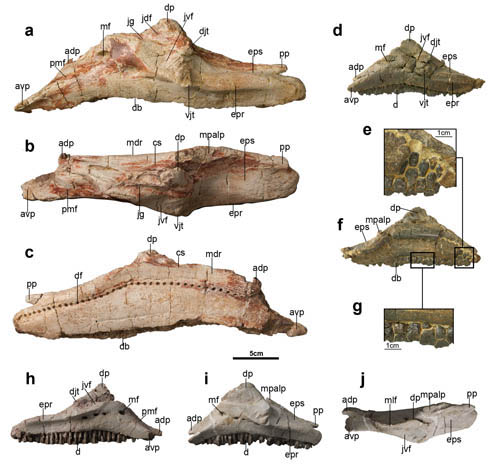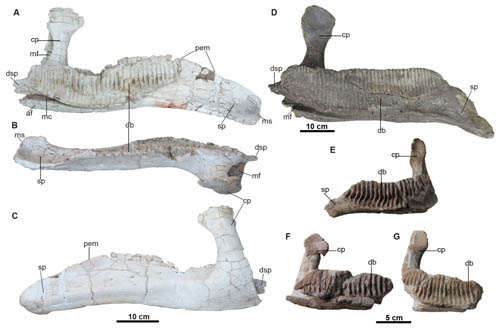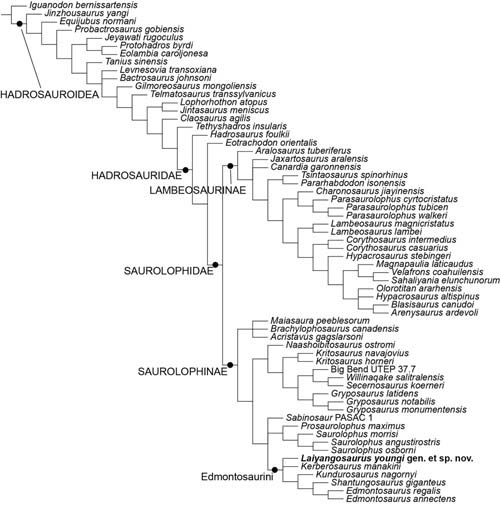Hadrosaurs are a type of large terrestrial herbivorous ornithischian dinosaurs that lived in the late Cretaceous period. Their fossils are widely distributed and have been found on other continents except Oceania. The most obvious features of hadrosaurs are the long and flat head with a snout shaped like a duck's bill, as well as a complex dentition and a powerful chewing system. The superfamily Hadrosauridae includes the more primitive basal taxa and the more advanced Hadrosauridae. Some members of the family hadrosaurids had different headdress structures. Due to the different shapes of their headdresses, hadrosauridae can be divided into flat-headed and solid headdresses, such as Ctenosaurinae, and laishosaurinae with hollow headdresses.
In the past ten years, the team of researcher Wang Xiaolin from the Institute of Vertebrate Paleontology and Paleoanthropology, Chinese Academy of Sciences, in cooperation with the Laiyang Municipal Government in Shandong Province, has conducted continuous field scientific investigations in Laiyang. Large-scale excavations have been carried out in the Cretaceous Wang Group strata at the site. Currently, five consecutive layers of enriched layers of dinosaur and other vertebrate fossils have been discovered at Site 2. A large number of vertebrate fossils, mainly dinosaurs, were collected through rescue operations and obtained Some important discoveries and research progress, such as the discovery of new materials and re-research on Qingdao dragon headdress. Wang Xiaolin and his doctoral student Zhang Jialiang conducted a detailed description and comparative study of some new hadrosaur skull materials, and named a new genus and species belonging to the hadrosauridae Ctenosaurinae - Laiyangosaurus youngi ), the species name is dedicated to Academician Yang Zhongjian, the founder of Chinese vertebrate paleontology, to commemorate the 120th anniversary of Yang Zhongjian’s birth and his important contribution to the study of dinosaur fossils in Laiyang. Relevant research results were recently published online in Anais da Academia Brasileira de Ciências.
Laiyang is located in the middle of my country's Shandong Peninsula. It is the place where Chinese geological paleontologists first discovered fossils of dinosaurs, dinosaur eggs, pterosaurs, insects and plants. It is also the place where the Chinese Society of Vertebrate Paleontology was born. It occupies a leading position in the study of dinosaur and other fossils in my country. An important position. The Cretaceous strata in Laiyang are complete and continuous, and contain three important Cretaceous fauna, namely the Early Cretaceous Jehol Biota, the Late Cretaceous Laiyang Hadrosaur fauna and the Laiyang dinosaur egg fossil group. Since the 1920s, Laiyang has experienced three important fossil discoveries. In 1923, Tan Xichou first reported the fossils of dinosaurs, fish, insects and plants found in the Cretaceous strata of Laiyang. At the same time, Gripp studied the insect and fish fossils, Zhou Zanheng studied the plant fossils, and Swedish paleontologist Wei Wei Wiman studied the dinosaur fossils and classified them as hadrosaurs, naming them Tanius sinensis Wiman (1929). In 1951, Yang Zhongjian, Liu Dongsheng and others conducted a large-scale investigation and excavation in Laiyang. They discovered the first dinosaur fossil skeleton after the founding of the People's Republic of China in Xigou of Jingangkou Village (now Site No. 1), and named the famous dinosaur after the founding of the People's Republic of China. Tsintaosaurus spinorhinus Young (1958), a head-dressed hadrosaur, as well as a large number of dinosaur and dinosaur egg fossils such as Tansaurus and Diamondostosaurus, and the first report of the winged wing discovered in Laiyang. Dragon fossil. Since then, some sporadic dinosaurs such as Pachycephalosaurus and dinosaur egg fossils have been discovered in Laiyang. Zhao Zikui also proposed a dinosaur egg classification and naming system mainly based on the research on dinosaur egg fossils in Laiyang. Since 2008, the Laiyang joint scientific expedition team led by Wang Xiaolin has conducted a detailed and comprehensive investigation of the Laiyang Group, Qingshan Group and Wangshi Group of the Cretaceous strata in Laiyang, and discovered dozens of new fossil locations and new layers. And a very rare plain dinosaur canyon group was discovered. At the same time, large-scale excavation and fossil and site protection work were carried out at two fossil sites in Jingangkou. At present, the Laiyang Cretaceous National Geopark, its paleontological museum and two dinosaur ruins museums have been established here, becoming a national key protected fossil origin and a scientific research and popularization base of the Institute of Paleovertebral Research.
Through the morphological and systematic study of the fossils of Laiyangosaurus Yangshi, researchers believe that Laiyangosaurus Yangshi is different from the basal members of the hadrosaurid superfamily represented by Tanshiosaurus and has the characteristics of an advanced hadrosauridae; at the same time, Yang's Laiyangosaurus is different from the head-dressed members of the Laiyasaurine subfamily represented by Qingdaoosaurus, and has obvious characteristics of the Ctenosaurinae. In addition, Laiyangsaurus Yang's also has some characteristics that distinguish it from other members of the Ctenosaurinae, such as the straight dorsal edge of the nasal bone and a narrow ridge on the outside; the main ridge of the maxillary tooth is posterior; and the posterior articular bone of the superior corner bone is pointed laterally. Curved; orbit wider than inferior temporal foramen, etc. The discovery of Laiyangosaurus Yangshi not only enriches the composition of the Laiyang hadrosaur fauna, but also provides new material for further discussion of the origin and evolution of hadrosaur-like dinosaurs.
This research was funded by the National Natural Science Foundation of China, the National Natural Science Foundation of China Basic Science Center Project, the Strategic Priority Science and Technology Project of the Chinese Academy of Sciences (Category B), and the Laiyang Municipal Government Cooperation Project.
Original link: http://www.scielo.br/pdf/aabc/2017nahead/0001-3765-aabc-201720160920.pdf

Figure 1 Maxilla of Laiyangosaurus Yang (photo courtesy of Zhang Jialiang and Wang Xiaolin)

Figure 2 The mandible of Laiyangosaurus Yang (photo courtesy of Zhang Jialiang and Wang Xiaolin)

Figure 3 Phylogenetic diagram of Laiyangosaurus Yang (photo courtesy of Zhang Jialiang and Wang Xiaolin)

Figure 4 Ecological restoration map of Yang’s Laiyangosaurus (drawn by Zhao Chuang)
animal tags: hadrosaurus dinosaur ornithischia cretaceous fossils evolution
We created this article in conjunction with AI technology, then made sure it was fact-checked and edited by a Animals Top editor.